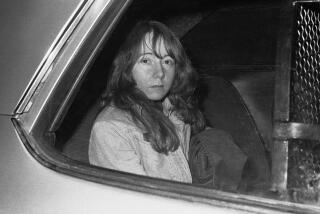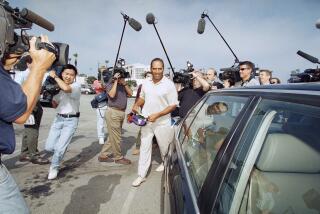Prober Tried to Fake Oswald Photo, FBI Report Says
- Share via
One of the late New Orleans Dist. Atty. Jim Garrison’s investigators, a man with reputed CIA connections, once tried to doctor a photograph to make it appear that Lee Harvey Oswald had met with Fidel Castro, a long-secret FBI document reports.
When it seemed impractical to put Oswald in the photograph because nobody in the original print was shaped like him, the report said, an attempt was made to place Oswald’s killer, Jack Ruby, in the picture with Castro.
And, when that would not work, the plot turned to inserting a picture of Clay Shaw, the man Garrison prosecuted unsuccessfully in 1969 on charges of taking part in a conspiracy to assassinate President Kennedy. That scheme failed as well.
The FBI report suggested that the investigator, Gordon Novel, wanted to “raise a doubt in the public’s mind” on whether Oswald alone murdered Kennedy. Only recently did the FBI agree to permit the release of this report and 20 other documents relating to the Kennedy assassination. It contended initially that making the documents public, as demanded by the Assassination Records Review Board, the federal agency that screens Kennedy assassination documents for release, would endanger national security by revealing investigative sources and methods. After the dispute went to President Clinton for resolution, the FBI backed down.
The purported attempt to doctor the photograph was hardly out of character for Garrison and his associates. Garrison was accused repeatedly of faking evidence in his investigation, and some of his witnesses in the Shaw case were not models of reliability, among them a man who showed up in court in a toga claiming he was Julius Caesar and another who testified he fingerprinted his daughter when she came home from school each day to be sure she wasn’t an impostor.
Novel, who could not be reached for comment, was a colorful adventurer who boasted of his CIA connections and dealings in illicit weapons. He claimed to be an electronic-eavesdropping expert, and advised White House aide Charles Colson during the Watergate investigation that President Nixon’s troublesome secret tapes could be erased at long distance by using a “laser cannon.”
The FBI’s interest in the photo-doctoring affair began in late 1976, when New Orleans agents interviewed a Cuban exile named Frank Bartes, an anti-Castro activist the bureau described as a reliable source on Cuban affairs. Before Castro seized power in 1959 and for months afterward, Bartes was president of the railroad that served the western half of Cuba. One day, Bartes said, he flew from Havana to the city of Camaguey. His plane landed within minutes of a plane carrying Castro. They were introduced and spoke for a few minutes, he said, and a news photographer shot a picture of them with several others. Bartes said he later obtained a print of the picture, which had been published in a Cuban magazine.
By 1975, Bartes said, he had settled in New Orleans and was actively opposing Castro. He said he met Novel, who was looking for anti-Castro activists who might want to buy weapons. “Novel displayed for Bartes an extensive array of all kinds of weapons, including conventional firearms, electronic equipment and even tanks and aircraft,” the FBI report said. Later, it said, Novel discussed with Bartes the reopening of the Kennedy investigation at that time by the House Select Committee on Assassinations.
Novel asked if Bartes had ever met Castro. Bartes said he had. Novel asked for proof, and Bartes pulled out a scrapbook containing the airport photograph. “Novel was greatly interested in the photograph,” the FBI report said.
“He asked Bartes if it would be possible to superimpose the head of Lee Harvey Oswald on top of one of the persons in that photograph, to make it appear that Oswald was at the same conference with Castro. Bartes, an amateur photographer, said that would be ridiculous, that it would be extremely difficult to do so and make it appear to be a real photograph, and then even so, it would not stand official scrutiny.”
There followed a similarly unsuccessful attempt to put Jack Ruby’s face in the picture. “Novel carefully examined the photograph, then pointed out one face on the right-hand edge and . . . said that this individual resembled Clay Shaw,” the report said. “Bartes said that such a resemblance was doubtful, but that such was an example of what Novel had in mind to raise a doubt in the public’s mind.”
The report did not say whether Novel was questioned about Bartes’ story.
In the late 1960s Novel had a falling-out with Garrison, who then had him indicted on charges of burglary in a munitions theft but was unable to get him extradited for trial from Ohio, where he had taken refuge. After Garrison had left the district attorney’s office in 1974, Novel returned to New Orleans and retained Garrison as his lawyer.
Novel last made news in the mid-1980s as director of security for sex magazine publisher Larry Flynt.
More to Read
Sign up for Essential California
The most important California stories and recommendations in your inbox every morning.
You may occasionally receive promotional content from the Los Angeles Times.










